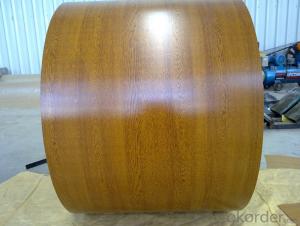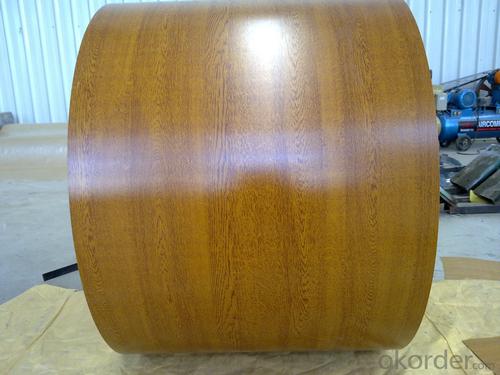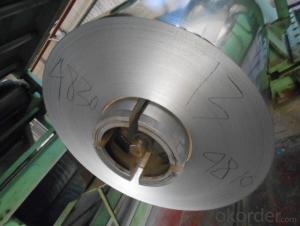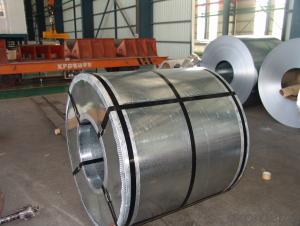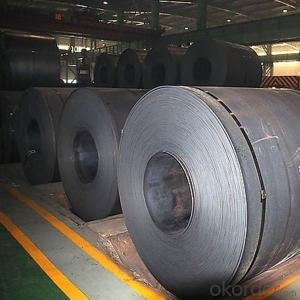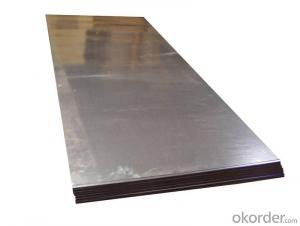Best Quality Printing Steel Coil Hot Sale
- Loading Port:
- Shanghai
- Payment Terms:
- TT OR LC
- Min Order Qty:
- 25 m.t.
- Supply Capability:
- 50000 m.t./month
OKorder Service Pledge
OKorder Financial Service
You Might Also Like
Product Description:
General Information Of Prepainted Galvanized Steel
With GI as base metal, after pretreatment (degrease and chemical treatment) and liquid dope with several layers of color, then after firing and cooling, finally the plate steel is called pre-painted galvanized steel. Pre-painted galvanized steel is good capable of decoration, molding, corrosion resistance. It generally displays superior workability, durability and weather resistance.
Thickness 0.23-1.2mm (BMT) |
Zinc Coating 80-275g/m2 |
Color According to RAL color fan |
Internal Diameter 508mm or 610mm |
Coil Weight 4-8MT |
Quality Commercial and structural quality |
Paint Polyester paint for topside, epoxy for reverse |
Standard JIS G 3312, ASTM A755M, EN 10169 |
Base Steel Grade SGCC,SGCD,DX51D+Z,DX52D+Z;S200GD,S220GD, S280GD,S350GD,CS,FS,SS |
Chemical Composition Of Prepainted Galvanized Steel
C | Si | Mn | P |
0.04-0.06% | 0.01-0.03% | 0.18-0.22% | 0.014-0.016% |
Technical Data Of Prepainted Galvanized Steel
Yield Strength | (Mpa) 280-320 |
Tensile Strength | (Mpa) 340-390 |
Elongation | 20%-30% |
Reverse Impact | 9J |
T-bending | ≥2T |
Pencil Hardness | ≥2H |
Duration Of Salt Spray Test | 500 H |
Bending At 180 Degree | No crack, purling and fraction |
Application Of Prepainted Galvanized Steel
Outdoor:
roof, roof structure, surface sheet of balcony, frame of window, door, door of garage, roller shutter door, booth, Persian blinds, cabana, etc.
In door:
door, isolater, frame of door, light steel structure of house, home electronic appliances, etc.
Packaging & Delivery Of Prepainted Galvanized Steel
Anti-damp paper inside full wrapped with plastic film, iron sheet outside on wooden pallet in 20 feet container with 25mt.
- Q: How are steel coils used in the manufacturing of shock absorbers?
- Steel coils are used in the manufacturing of shock absorbers primarily as a spring component. These coils provide the required strength and flexibility to absorb and dampen the impact and vibrations experienced by the vehicle. When compressed or expanded, the steel coils store and release energy, ensuring a smoother and more controlled ride for the driver and passengers.
- Q: What are the common defects in steel coils?
- Some common defects in steel coils include surface defects like scratches, rust, and pits, as well as internal defects like cracks, laminations, and non-uniform thickness. Other defects may include coil set, which is a curvature in the coil, and edge wave, which is a distortion along the edges of the coil.
- Q: How are steel coils inspected for damage during transportation?
- Steel coils are inspected for damage during transportation through various methods such as visual inspections, magnetic particle testing, ultrasonic testing, and dimensional checks.
- Q: How are steel coils used in the production of agricultural equipment?
- Steel coils are used in the production of agricultural equipment as they are often shaped and formed into various components such as frames, chassis, and structural parts. These coils provide strength, durability, and stability to the equipment, making it capable of withstanding the demanding conditions and heavy workloads typically associated with agricultural tasks.
- Q: Can steel coils be recycled?
- Yes, steel coils can be recycled. Steel is a highly recyclable material, and the recycling process for steel coils involves melting them down and reshaping them into new products. This helps conserve natural resources, reduce energy consumption, and minimize waste.
- Q: How are steel coils labeled and identified?
- Steel coils are labeled and identified through a variety of methods to ensure proper tracking and handling throughout their journey. The labeling and identification process typically involves the following steps: 1. Manufacturer's Identification: The steel coil is initially marked with the manufacturer's name or logo, allowing for easy identification of the company that produced it. 2. Coil Number: Each steel coil is assigned a unique identification number, commonly referred to as a coil number. This number is often stamped or etched onto the surface of the coil and is used for tracking and inventory purposes. 3. Size and Weight: Steel coils are labeled with their size and weight specifications. This information helps in determining the dimensions and weight capacity of the coil, allowing for appropriate handling and transportation arrangements. 4. Grade and Material: The grade and material composition of the steel coil are typically indicated on the labeling. This provides essential information about the properties and quality of the steel, ensuring it is utilized correctly in manufacturing processes. 5. Heat or Lot Number: Steel coils can also be labeled with a heat or lot number, which refers to the production batch from which the coil originated. This information helps in traceability and quality control, facilitating identification in case of any issues or defects. 6. Barcodes or QR codes: Many steel coils are now labeled with barcodes or QR codes, which can be scanned using automated systems. These codes contain all relevant information about the coil, allowing for efficient data capture and management throughout the supply chain. Proper labeling and identification of steel coils are crucial for effective logistics management, inventory control, and quality assurance. By employing these identification methods, manufacturers, distributors, and end-users can easily track, handle, and utilize steel coils in a safe and efficient manner.
- Q: What are the applications of stainless steel coils?
- Stainless steel coils have a wide range of applications across various industries due to their unique properties and characteristics. Some of the key applications of stainless steel coils include: 1. Manufacturing industry: Stainless steel coils are extensively used in the manufacturing sector for the production of various products such as automotive parts, kitchen appliances, machinery components, and construction materials. The high corrosion resistance and durability of stainless steel make it an ideal choice for these applications. 2. Construction industry: Stainless steel coils are widely used in the construction industry for applications such as roofing, cladding, structural supports, and reinforcement. The strength, resistance to harsh weather conditions, and aesthetic appeal of stainless steel make it a popular choice in architectural designs. 3. Food processing industry: Stainless steel coils are commonly utilized in the food processing industry for equipment such as food storage tanks, conveyors, and processing machinery. Stainless steel's hygienic properties, resistance to corrosion, and ease of cleaning make it suitable for maintaining the purity and safety of food products. 4. Chemical industry: Stainless steel coils find extensive usage in the chemical industry due to their excellent resistance to corrosion from chemicals and harsh environments. They are used in the production of storage tanks, pipelines, and reactors that handle various chemicals and corrosive substances. 5. Energy industry: Stainless steel coils are widely employed in the energy sector for applications such as power generation, oil and gas exploration, and renewable energy systems. They are used in heat exchangers, turbine components, pipelines, and offshore structures due to their high resistance to corrosion, strength, and longevity. 6. Medical and pharmaceutical industry: Stainless steel coils are commonly used in medical and pharmaceutical applications due to their biocompatibility and resistance to corrosion. They are used in the production of surgical instruments, medical implants, and medical equipment that require sterilization and durability. 7. Automotive industry: Stainless steel coils are utilized in the automotive sector for various components like exhaust systems, fuel tanks, catalytic converters, and structural parts. Stainless steel's high heat resistance, strength, and resistance to corrosion and oxidation make it suitable for these applications. These are just a few examples of the wide range of applications of stainless steel coils. Their versatility, durability, and resistance to corrosion make them indispensable in numerous industries where reliability and longevity are crucial factors.
- Q: How are steel coils used in the production of pipes and tubes?
- Steel coils play a crucial role in the manufacturing of pipes and tubes. They serve as the primary material for shaping the cylindrical structure of these products. The process begins by unrolling the coils and feeding them into a pipe or tube mill, where a series of manufacturing procedures take place. Initially, the steel coils are unwound and straightened to eliminate any bends or twists. Subsequently, the edges of the coils are trimmed to ensure a smooth and even surface, a technique referred to as slitting. Following this, the coils are passed through a forming machine, which bends them into the desired shape. For pipes, the coils are shaped into a circular form, whereas tubes can be molded into different configurations like square, rectangular, or oval. Once the coils have been shaped, they are welded together along their length to create a continuous pipe or tube. This welding process can be accomplished using a variety of techniques, such as high-frequency induction welding, electric resistance welding, or submerged arc welding. After the welding process is complete, additional procedures may be carried out on the pipes or tubes to enhance their properties. These procedures may involve heat treatment, like annealing or quenching, to improve strength or hardness. Finally, the pipes or tubes are cut to the desired length and may undergo further finishing processes, such as straightening, polishing, or coating, depending on their intended application. In summary, steel coils serve as the foundational material in the production of pipes and tubes. They are unrolled, straightened, and molded into the desired shape before being welded together to create a continuous product. Additional processes can be applied to improve the properties and meet specific requirements of the pipes or tubes.
- Q: No. Not Stainless steel, I mean STEEL.Not a specific type, but STEEL.Thanks. xo
- This Site Might Help You. RE: Is Steel a Pure Substance or a Mixture? No. Not Stainless steel, I mean STEEL. Not a specific type, but STEEL. Thanks. xo
- Q: I have some steel wool and a charged 9V Battery, when I connect 2 wires to the battery, then touch the wool with the ends of the wires the wool instantly starts burning, but when I connect 2 wires to the piece of steel wool (a new piece not same one of course) and touch the battery with the ends of the wire nothing happens (see image...)
- What's happening in the first case is that the initial contact of the wire to the steel wool is not very good and there is a high resistance as the touch is made and there is probably a slight spark that starts the steel wool burning. Now it is even harder to make good contact and the process continues. In the second case there is initially a good contact to the steel wool and there is no spark when the circuit is completed at the battery. It would be difficult to cause the heating and the spark at a distance unless you had a way to remotely cause the wire to lightly touch the steel wool. A gas lighter which uses a flint to create a spark is good for igniting a gas burner which will continue to burn by itself, but probably wouldn't cause the steel wool to burn without the energy coming from the battery to keep it going. Steel wool WILL continue to burn if it's in a pure oxygen atmosphere. You might try hooking the battery up to the steel wool as in the second case and using a spark lighter to start some burning close to one of the wire connections to see if the extra battery power might keep the burning going.
Send your message to us
Best Quality Printing Steel Coil Hot Sale
- Loading Port:
- Shanghai
- Payment Terms:
- TT OR LC
- Min Order Qty:
- 25 m.t.
- Supply Capability:
- 50000 m.t./month
OKorder Service Pledge
OKorder Financial Service
Similar products
Hot products
Hot Searches
Related keywords
